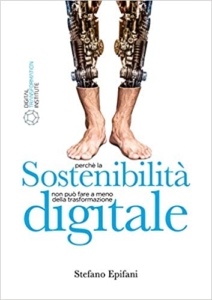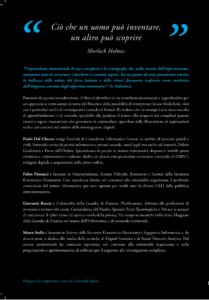Che cos’è la sostenibilità digitale? Ce lo spiega il libro del prof. Stefano Epifani.

“La sostenibilità digitale […] rappresenta un elemento di supporto che deve arricchire la sostenibilità ambientale, quella economica e quella sociale, rappresentando un elemento abilitante e – nel contempo – una chiave di lettura della tecnologia […]”
Lo ammetto: recensire il libro “Perché la sostenibilità non può fare a meno della trasformazione digitale“, scritto qualche mese fa dal prof. Stefano Epifani per i tipi del Digital Transformation Institute non è una cosa affatto semplice.
E non perché il testo sia complesso, tutt’altro: è scritto in maniera molto lineare, comprensibile e leggera, rendendo peraltro appetibili anche ai meno esperti del settore una serie di temi piuttosto complessi ed interdisciplinari, rifuggendo da particolari o nomenclature tecniche.
E, infatti, del libro di Stefano Epifani si comprende anzitutto questo: non occorre essere dei tecnici per capire le nuove tecnologie, ma bisogna aprirsi a ciò che nuovo e – quanto meno – provare a diventare dei tecnologi, nella consapevolezza che l’uomo del nostro tempo non può far finta di nulla e voltarsi dall’altro lato, quando si tratta di nuovi strumenti che impattano inevitabilmente sulle nostre vite.
Partendo dalla definizione di “sostenibilità“, che subito – com’è giusto che sia – ci fa pensare a questioni ambientali, il prof. Epifani ci introduce ai concetti, più articolati, di sostenibilità ambientale, economica e sociale.
Non ci soffermeremo sulle definizioni ma, come recita il testo di cui stiamo parlando, occorrerà sempre ricordare come “il sistema economico, quello sociale e quello ambientale sono – sempre – strettamente collegati tra loro: qualsiasi cosa si faccia agendo su uno di essi ci saranno impatti sugli altri“.
In termini estremamente sintetici e assolutamente non esaustivi: la sostenibilità – come principio guida delle tecnologie e delle scienze umane – può consentire un uso virtuoso dell’ambiente, dell’economia e della società in maniera da impiegarli e viverli al meglio nel presente; essa però prevede che l’uomo di oggi preservi il loro uso e godimento nelle migliori condizioni anche per le generazioni future.
A corollario di tutto, non potendo ignorare quanto succede alla tecnologia ormai da molti anni, la sostenibilità digitale si pone come strumento di perfezionamento, di integrazione, di miglioramento ed ottimizzazione dei tempi, delle dinamiche e dello studio dei vari macro-temi che sottendono alla sostenibilità in generale.
Anzi, dopo la lettura di questo testo, è facile comprendere come la sostenibilità digitale non sia un corollario ma, ormai, sia divenuta la base – o quanto meno, un punto fermo – della sostenibilità in senso generale.
Percorrendo anche gli albori ed i primi passi delle “nuove” tecnologie (ormai non tutte così “nuove”, come internet), questo libro ci guida in maniera ordinata verso le varie pietre miliari che hanno scandito il percorso dell’uomo tecnologico e ci guida, gradualmente, verso l’internet delle cose, i big data o l’intelligenza artificiale, spiegandoci tutto senza formule o enunciazioni di leggi fisiche o chimiche.
Ma non solo: in un succedersi di dicotomie volte a meglio comprendere le tecnologie e la sostenibilità digitale (reale/virtuale, sicurezza/libertà, privacy/controllo, apertura/chiusura, possesso/consumo, utente/attore) è possibile capire le differenze e, talvolta, anche i tranelli – non solo semantici – che si nascondono dietro alcune espressioni che tutti crediamo di possedere e di padroneggiare.
Il rischio, però, è quello di essere sbugiardati: siamo davvero sicuri di conoscere “compiutamente” i concetti di sharing economy, di car sharing, di home restaurant, di social eating, di copyright o copyleft (e l’elenco potrebbe continuare…)?
Passando dai social media agli smart grid, dagli smart whatch allo smart farming, questi termini – solo per citarne alcuni – ci sembrano apparentemente noti e chiari, ma in realtà nascondo insidie: il libro di Epifani cerca però di aprire gli occhi, di confutare il complottismo ed il timore che ultimamente si è ingenerato nelle nuove tecnologie; esso ci insegna, invece, a non preoccuparci delle “insidie“, ma a comprendere e ad utilizzare le nuove tecnologie in maniera consapevole, proprio per non averne paura e per produrre dei benefici per chi verrà dopo di noi.
Insomma: nel libro si fondono storia, tecnologia, sociologia, antropologia, comunicazione.
Ma è anche un racconto, non necessariamente fantascientifico: per porre il lettore nelle migliori condizioni di comprendere quanto sta per leggere, ogni capitolo è preceduto da una specie di tale immaginario, che ipotizza – ai giorni nostri – personaggi contemporanei alle prese con le nuove tecnologie e ne racconta, nel bene e nel male, i pensieri e le sensazioni. Come reagiranno un tassista, un giornalista, un medico o un agricoltore di fronte alle innumerevoli svolte tecnologiche ormai possibili ed accessibili per tutti?
Il libro, sostanzialmente, ci illustra una nuova filosofia, ma non trascura nemmeno il diritto (internazionale e non): il particolare fondamentale da noi finora omesso, infatti, è che l’analisi di Epifani muove in parallelo con i vari task ed obiettivi di sviluppo sostenibile assegnati “all’umanità” dall’Agenda 2030 e tiene in considerazione anche la Dichiarazione di Rio sull’ambiente e lo sviluppo, i Millennium Development Goals, il Manifesto per la Sostenibilità Digitale e quello sulle Fake news… il tutto partendo dal Red Flag Act promosso dalle autorità del Regno Unito per “ostacolare” lo sviluppo dell’automobile e favorire cocchieri e carrozze nella Londra di quasi due secoli fa.
Un testo consigliatissimo, un manuale per comprendere – anche da profani – le nuove tecnologie, uno spunto di approfondimento per ulteriori riflessioni e un “vaccino” per evitare paure e fobie verso il mondo che verrà.
Disponibile su carta e, ovviamente, in formato digitale, oltre alla ricca bibliografia il testo vanta un’introduzione a cura di Alberto Marinelli (direttore del Dipartimento di Comunicazione e Ricerca sociale – CoRis – de “La Sapienza”), la prefazione a cura di Enrico Giovannini (portavoce dell’Alleanza Italiana per lo Sviluppo Sostenibile e professore dell’Università “Tor Vergata”) e la postfazione a cura di Sonia Montegiove (direttrice editoriale di Tech Economy 2030).
Domenico Martinelli
Profilo sintetico dell’autore:
Stefano Epifani è docente di Internet Studies in Sapienza, Università di Roma, dove insegna dal 2003. Giornalista e advisor internazionale sui temi di sostenibilità digitale, dal 2010 collabora con agenzie delle Nazioni Unite ed altre istituzioni sul tema degli impatti della trasformazione digitale applicata i processi si sviluppo urbano sostenibile.
Nel 2012 ha fondato Tech Economy, oggi Tech Economy 2030: il primo magazine digitale italiano dedicato alla sostenibilità digitale. Nel 2015 ha fondato il Digital Transformation Institute, istituto di ricerca di cui è tutt’oggi presidente.
Recensione pubblicata dallo stesso autore sulla rivista euNOMIKA a questo link.


 Nell’era dell’intelligenza artificiale, dell’internet delle cose e del 5G che stanno cambiando e cambieranno la nostra vita di tutti i giorni, forse fino a stravolgerla del tutto, non tutti sappiamo esattamente cosa siano le criptovalute o come utilizzare la blockchain.
Nell’era dell’intelligenza artificiale, dell’internet delle cose e del 5G che stanno cambiando e cambieranno la nostra vita di tutti i giorni, forse fino a stravolgerla del tutto, non tutti sappiamo esattamente cosa siano le criptovalute o come utilizzare la blockchain. 


